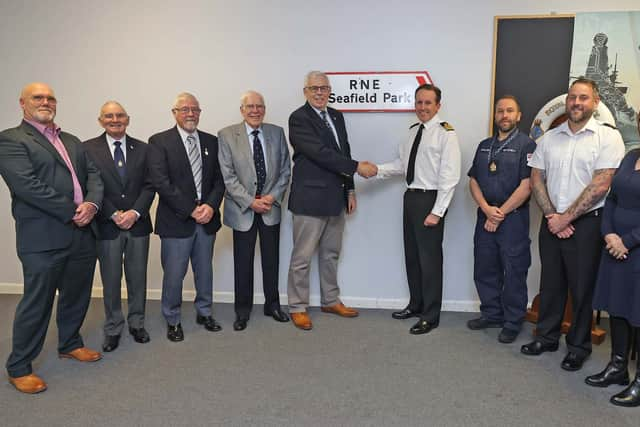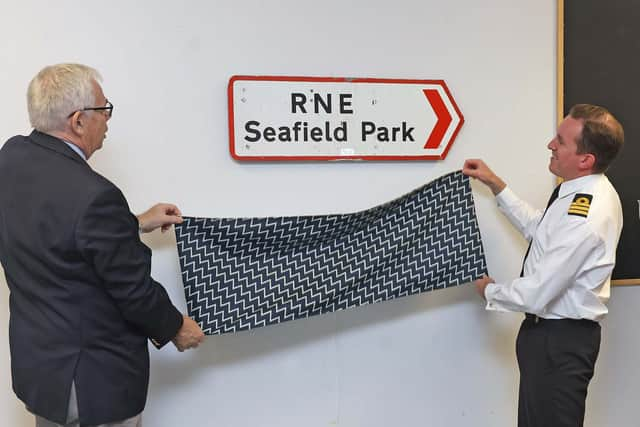HMS Sultan: Royal Navy memorial sign set up in Gosport to honour 80 years of branch's life-saving work
and live on Freeview channel 276
The mural has been put up on a wall at HMS Sultan to mark the 80th anniversary of the Royal Navy Safety Equipment and Survival Branch. Veterans joined serving personnel to celebrate the unit's successes. The branch created safety equipment for military personnel who flew aircraft at sea.
Lieutenant Commander John Scivier, president of the Royal Naval Safety and Survival Equipment Association - and former Commanding Officer of HMS Victory - said it was important to honour those who carried out the work past and present. I spent nine years in the Safety Equipment Branch. Seafield Park was the home of training for most people in the association, it was the training environment which we would all know.
Advertisement
Hide AdAdvertisement
Hide Ad

"It was a unique place which took you away from the Royal Navy into a country home environment, we all have very fond memories of it. A lot has changed since, with personnel recognised now as Safety Equipment Technicians, meaning their technical skills are being recognised. We hope the sign, donated by association member John Vitti, will offer some inspiration to those now coming through training.”
The branch came into its own at the beginning of the Second World War, with the numbers of the Fleet Air Arm swelling and the carrier replacing the battleship. Sea survival technology rapidly advanced throughout the conflict. Gas inflatable life preservers were introduced at the beginning of the war, inflatable life rafts were included in multi-crew aircraft and leather helmets offered personnel better protection.
Until 1943, equipment was maintained at sea by trained seaman specialists – and ashore by Wrens, trained by RAF personnel. The branch was formed in November 1943 as safety equipment became increasingly complicated. After previously being hosted at HMS Siskin in Gosport, HMS Raven in Eastleigh and RNAS Daedalus in Lee-on-the-Solent, the unit has been at HMS Sultan since 1996.


By far the longest period of the branch’s 80-year existence – some 35 years – were spent at Seafield Park in Hill Head, a village just along the Solent from Lee-on-the Solent. From 1956 until 1991 when the site was sold, the old country house/school served as a unique training environment for personnel assigned to the small but vital branch – and remains its most fondly remembered location, hence the unveiling of the old road sign as a memorial. Today, the branch is responsible for Nuclear, Biological and Chemical Defence (NBCD) clothing, high-tech helmets used on Apache helicopters and F-35 jets and equipment for other uses.
Advertisement
Hide AdAdvertisement
Hide AdThousands of naval aviators past and present have are eternally grateful for the work of the branch. First Sea Lord Admiral Sir Ben Key, who served as an Observer in Lynx helicopters in the 1980s and 1990s, said: "Please pass my best wishes to the Association, not least because I once had to use their equipment 'in anger' and neither it, nor the training provided in how to use it, let me down.
"So I am for ever grateful to them for the vital role they play in ensuring we save life at sea when things go wrong. And I know I am not alone in being so."
Comment Guidelines
National World encourages reader discussion on our stories. User feedback, insights and back-and-forth exchanges add a rich layer of context to reporting. Please review our Community Guidelines before commenting.